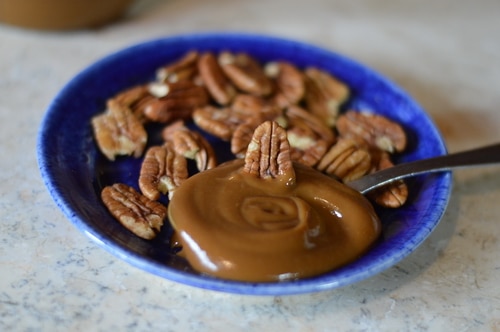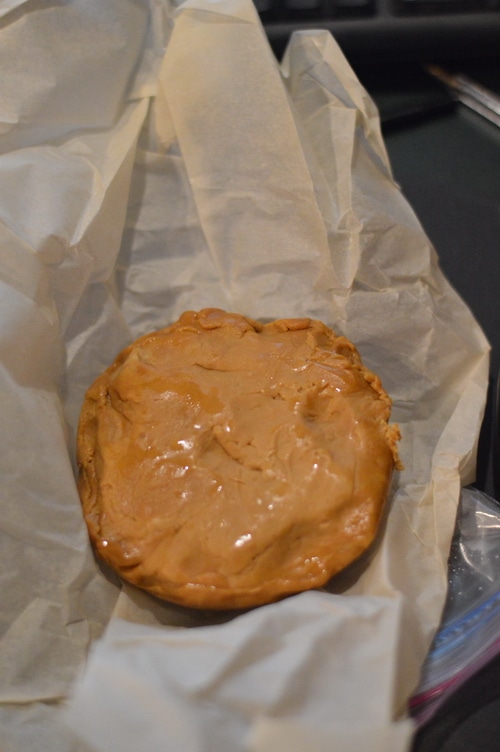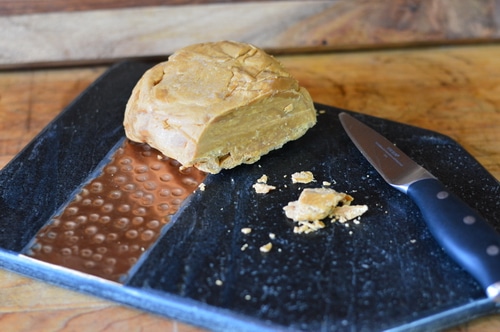We have an abundance of goat’s milk for the first time since getting goats 16 years ago. While we’ve been milking goats for all those years, it was rare for us to have more than just a little milk for our coffee. Every year we’ve had at least one, and often 3 or 4 orphaned lambs or goat kids that needed the milk more than we did. But this year there are no orphans and all the milk is coming into the kitchen every night. Yay!

In other years I would get to make five or six batches of cheese between weaning the bottle babies and the start of breeding season when the milk supply dwindled. Then we’d be down to just enough milk for coffee, again. With goat’s milk you really want fresh milk for cheese making, so no saving up milk for several days just to make cheese.

Chedvah is one of this year’s milking does. She was a bottle baby last year.
I’m making cheese almost daily right now. And that is a lot of whey to deal with. It always amazes me that after the cheese curds are removed how much whey is actually left. So lately I’ve been looking for ways to utilize the whey from cheese making better.
What to do with all that whey?
I make ricotta cheese and one 6 litre/quart batch of whey yields about 1 ½ cups of ricotta. There’s still more than 5 quarts of whey left. So once you’ve taken out 2 pounds of hard cheese and 1 ½ cups of ricotta cheese what’s left isn’t just water.

Whey has all the B-vitamins, plus calcium, phosphorous, potassium, selenium, zinc, and magnesium. Whey is also a high quality protein. When milk is separated into curds and whey to make cheese, the casein protein goes with the cheese curds, while the serum protein stays with the whey. Serum protein is a complete protein. (http://www.livestrong.com/article/533194-nutritional-value-of-milk-whey-liquid/) Most of the carbohydrates in whey are in the form of milk sugar or lactose. That’s why people who are lactose intolerant can often eat cheese, much of the lactose is removed with the whey.
It seems a shame to dump the whey down the sink. Certainly it would be better to pour it on the garden. Whey has a fertilizer potential of Nitrogen 1.22, Phosphorous .40, Potassium 1.46, plus calcium, magnesium, sodium, and chlorine.
But what if you could turn whey into more food? Well it turns out you can.
Whey is high in lactose aka milk sugar. After you’ve taken your hard cheese and your ricotta cheese, that 5 quarts of leftover whey can be simmered down to make several sweet confections. Different countries traditionally made different sweet confections from the whey. In Mexico Dulce de Leche a caramel-like sauce that is served like, well, caramel is made from the whey plus added sugar and cream. It can be cooked down further to a fudge-like consistency then beaten like fudge and poured into molds or further cooked into toffee.
It doesn’t taste quite the same as caramel made with milk and sugar, though. It has a more complex flavour, sweet, with a slight saltiness, and a slightly sour finish. It reminds me of salted caramels. I had visions of toasted pecan cheese cake drizzled with it just before serving.

Dulce de leche made from whey.
Gjetost is another cheese that can be made from goat whey. When made from cows’ milk whey it is called Mysost. I found a recipe for it inThe Art of Natural Cheese Making by David Asher (2015)(p. 260 to 262). It is more dessert than cheese, with a fudge-like consistency.

Gjetost is made by slowly simmering whey in a pot until the liquid is reduced to one fourth its volume and has taken on a light caramel colour. At this point cream is added to the whey and it is cooked more quickly, stirring constantly to prevent large lactose crystals from forming in the cheese. The cheese will continue to caramelise turning from golden brown to darker brown. It will begin to solidify in the bottom of the pan. At this point the cheese is removed from the heat and beaten with a spoon, in the same way that fudge is beaten. Then it is poured into buttered molds to cool.
Gjetost can take two days to make. I found that using myInstant-Pot™ to simmer down the whey was much easier and used less energy than simmering on the stove top. There is no need to stir it at this point. I left the lid off it though, to encourage evaporation.
Near the end of the cooking time, I turned my Instant-Pot™ to sauté with medium heat and that was just right to finish the cheese, without burning.
How to make Gjetost
Ingredients:
1 to 2 gallons of sweet whey left from cheese making or ricotta making
1 to 2 cups of sweet, heavy cream
2 tbsp. of butter (to reduce foaming)

Method:
Simmer the whey in a slow cooker or Instant-Pot on medium heat for several hours or overnight with the lid off. There is no need to stir this.
When the volume of the whey is reduced by 75%, add the cream and butter. Turn up the heat. Use the sauté feature on the Instant-Pot on medium heat. Stirring constantly simmer the whey while it reduces further and caramelizes.

The whey will turn browner as it caramelises. If it begins to burn, turn the heat down. Once it is thickened, it will coat a spoon, and you can part the liquid without it running back into itself, remove from the heat. How long you cook it, the degree of browning, and how long you stir it for determine the final consistency of the Gjetost. Continue stirring for several minutes to prevent large lactose crystals from forming. Pour into buttered molds. Allow it to cool.
The brown cheese is very hot at this point so plan to use stainless steel molds rather than plastic molds. Plastic molds will melt and warp. (The voice of experience).

How to store Gjetost:
Once it is cooled it can be wrapped in parchment paper and refrigerated. It will keep indefinitely in the fridge.

How to serve Gjetost:
The cheese is sweet, sour, and salty. In Norway it is served for breakfast, sliced very thinly, with fruit and rye bread. It’s tucked into school lunches with lingon berry jam and rye crackers. It melts well in fondue. It can be grated and used sparingly as a pizza topping. In Norway it is called “Ski Cheese” and taken on excursions as a trail food.

I did wonder if I should make gjetost before I made ricotta with the whey or after. I did it both ways. The gjetost made from whey that had not been used for ricotta was sweeter and more caramel-like, both in taste and texture. I had to blend it with an immersion blender just after I added the butter and the cream, to incorporate milk curd that had separated out of the whey as it reduced. The gjetost make after ricotta making had a more earthy-leathery finish and didn’t need to be blended with the immersion blender to give it a creamy texture.
Yield from 6 quarts of goat’s milk

Here’s my yield from 6 quarts of raw goat’s milk:
- 2 lbs of hard cheese
- 1 cup of ricotta
- 400 grams of gjetost
Your turn:
What do you make with your whey? Have you tried gjetost before? How about mysost?



Did you heat the ricotta? For ricotta cheese, the milk is heated. Then the lemon juice is added. It is cooked at a low temperature until the milk separates into curds, then it is strained. The whey is clear liquid, mine is usually yellow in color but clear. The milk curds are white and hold together somewhat. Its just the whey that is used for gjetost.
I am new to this and wonder. I just did 1 1/2 gallons goats milk with 2 cups lemon juice and strained off with cheese cloth now is this ricotta and the next step as iv never made ricotta or do I just do the next steps at this point.
Dulce de Leche is from Argentina, not from Mexico.
I have yogurt whey. Can Gjetost be made with that?